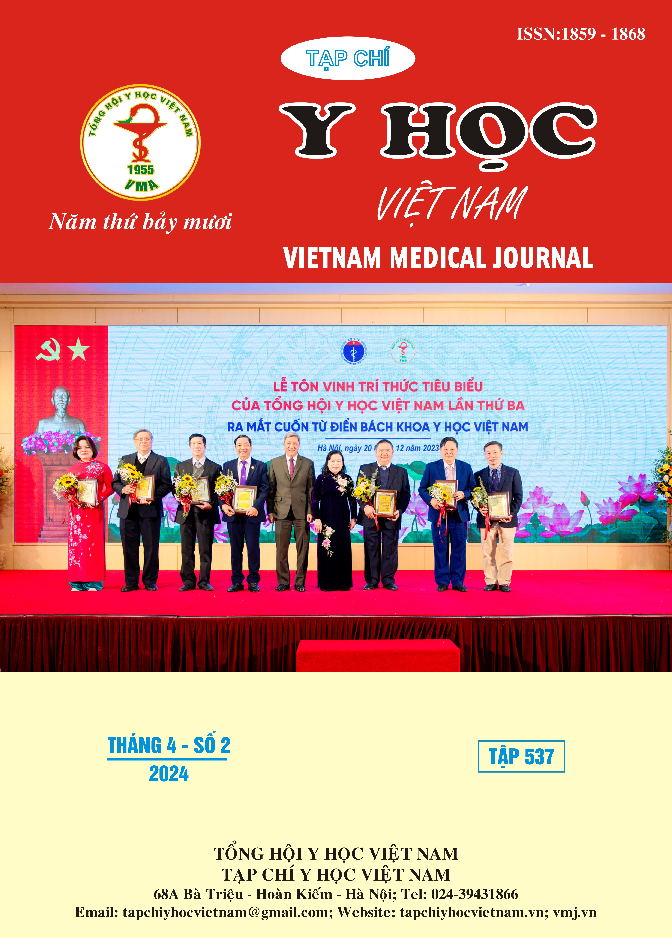EVALUATE THE RELATIONSHIP BETWEEN KIDNEY STONE SURFACE AREA AND THE DEGREE OF RENAL PELVIS DILATATION ON MULTI-SLICE COMPUTED TOMOGRAPHY WITH PERCUTANEOUS NEPHROLITHOTRIPSY TIME
Main Article Content
Abstract
Purposes: The aim of this study was to evaluate the relationship between kidney stone surface area on multi-slices computed tomography and percutaneous nephrolithotomy (PCNL) time. Material and methods: Descriptive study at Hanoi Medical University Hospital from July 2022 to July 2023 on 71 patients with kidney stones undergoing PCNL and multi-slices CT scans before PCNL and checked the stone cleanliness after PCNL. The stone surface area was calculated for each patient according to the formula S=π/4 x length x width of stone and classified into levels <400 mm2, from 400-799 mm2, from 800 -1599 mm2 and >1600 mm2 and then compared with PCNL time to determine the relationship between these two factors. Results: Mean age was 53.8±12.3. Male/female ratio was 1.54. The proportion of stones with surface area <400 mm2 (=21), from 400-799 mm2 (n=30), from 800 -1599 mm2 (n=14) and >1600 mm2 (n=6) were 29.6%, 42.3% 19.7% and 8.5% respectively and corresponded to PCNL time (in minutes) of 50.8±12.6, 62.7±25.0, 83.3±42.4 and 112.5±41.4. There was a statistically significant difference (p=0.003) of PCNL time between the different stone surface area groups. The proportion of patients with nondilated (n=2), mildly dilated (n=43), moderately dilated (n=21) and severely dilated (n=5) renal pelvises was 2.8%; 60.6%; 29.6% and 7%, respectively. The PCN lithotripsy time (in minutes) of the non-dilated or slightly dilated renal pelvis group and the moderately dilated or severely dilated group were 59.6±26.7 and 81.8±38.4, respectively. There was a statistically significant difference (p=0.006) in PCNL time between these two groups. Conclusion: Kidney stone surface area and the degree of renal pelvic dilatation was associated with PCNL time with p < 0.05. Evaluation of these two parameters played an important role for the prediction of PCNL success
Article Details
Keywords
Kidney stone surface area, renal pelvic dilatation, percutaneous nephrolithotomy, multi-slices computed tomography.
References
2. Bùi Văn Lệnh. Chẩn Đoán Hình Ảnh Bộ Máy Tiết Niệu. Nhà xuất bản y học; 2011.
3. Hoàng Long. In: Bài Giảng Bệnh Học Ngoại Khoa. 2013:203-204.
4. Smith RC, Rosenfield AT, Choe KA, et al. Acute flank pain: comparison of non-contrast-enhanced CT and intravenous urography. Radiology. 1995;194(3):789-794. doi:10.1148/ radiology.194.3.7862980
5. Ujwal Kumar et al. STONE score versus Guy's Stone Score - prospective comparative evaluation for success rate and complications in percutaneous nephrolithotomy. Urol Ann. 2018 Jan-Mar; 10(1): 76–81.
6. Lai WH, Jou YC, Cheng MC, et al. Tubeless percutaneous nephrolithotomy: Experience of 1000 cases at a single institute. Urological Science. 2017;28(1):23-26.
7. Liu Y, Chen Y, Liao B, et al. Epidemiology of urolithiasis in Asia. Asian J Urol. 2018;5(4):205-214. doi: 10.1016/j.ajur.2018.08.007
8. Ozgor F, Kucuktopcu O, Sarılar O, et al. Does previous open renal surgery or percutaneous nephrolithotomy affect the outcomes and complications of percutaneous nephrolithotomy. Urolithiasis. 2015; 43(6):541-547. doi:10.1007/ s00240-015-0798-9.
9. Bartoletti R, Cai T, Mondaini N, et al. Epidemiology and risk factors in urolithiasis. Urol Int. 2007;79 Suppl 1:3-7. doi:10.1159/000104434
10. Segura JW, Patterson DE, LeRoy AJ, et al. Percutaneous removal of kidney stones: review of 1,000 cases. J Urol. 1985;134(6):1077-1081.


